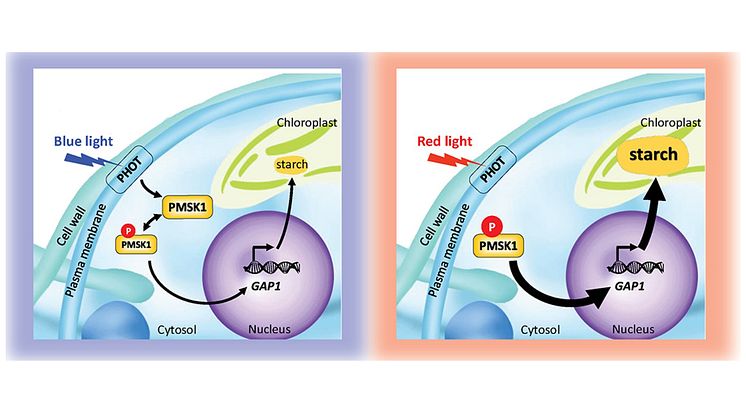
Press release -
Controlling starch levels in algae could reduce greenhouse gases
High-starch algae are important in biofuel production, as a feed supplement in agriculture and as an efficient way to bind carbon dioxide. Researchers have now found a new method to control starch storage in algae - a finding with potential applications in areas such reducing greenhouse gases.
Peer-review / Experimental study / Cells
“Modifying a blue light-activated signalling pathway makes it possible to regulate storage. This offers a significantly higher yield than traditional methods that rely on nutrient deprivation,” says Dimitris Petroutsos, Associate Professor at Uppsala University, who led the study recently published in Nature Communications.
Light is essential for photosynthetic organisms such as plants and algae. In green algae, such as Chlamydomonas reinhardtii, the energy from sunlight is used to convert carbon dioxide (CO₂) into carbohydrates, which can be used for growth or stored as energy in the form of starch.
Special effect of blue light
In the new study, researchers show that blue light has a special effect. It affects starch storage in algae through a protein called phototropin. When phototropin senses blue light, it activates a signalling pathway that reduces starch accumulation by controlling key metabolic genes. This light-driven regulation of carbon storage allows algae to fine-tune their energy allocation between immediate growth (low starch) and long-term storage (high starch).
The researchers found that genetically modified algae without phototropin increased starch content from 5 to 25 per cent of the dry weight of the algae – without compromising growth or photosynthesis.
Could reduce greenhouse gases
Three areas that could benefit most from greater regulation of starch storage are:
Biofuels: Starch-rich algae can be used to produce bioethanol and other biofuels. Manipulating phototropin signalling makes it possible to increase starch production in a controlled manner.
Sustainable agriculture: Microalgae are used as a feed supplement in agriculture. Controlling starch storage would make it possible to improve the nutritional value of the supplements and make them more efficient as animal feed and soil enhancers.
Carbon capture: By controlling starch accumulation, we can influence how algae store carbon, which could help capture carbon dioxide and reduce greenhouse gases.
“Previous studies have mostly focused on how nutrient deficiency affects starch formation, but in this study we have been able to show that blocking the phototropin pathway makes it possible to increase starch storage without affecting growth,” says Petroutsos.
Article: Yuan, Y., Iannetta, A.A., Kim, M. et al. Phototropin connects blue light perception to starch metabolism in green algae. Nat Commun 16, 2545 (2025).
For more information:
Dimitris Petroutsos, Associate Professor at the Department of Organismal Biology; Physiology and Environmental Toxicology, Uppsala University; email: dimitris.petroutsos@ebc.uu.se, mobile: +46-70-167 91 12
Topics
Categories
Founded in 1477, Uppsala University is the oldest university in Sweden. With more than 50,000 students and 7,500 employees in Uppsala and Visby, we are a broad university with research in social sciences, humanities, technology, natural sciences, medicine and pharmacology. Our mission is to conduct education and research of the highest quality and relevance to society on a long-term basis. Uppsala University is regularly ranked among the world’s top universities. www.uu.se

